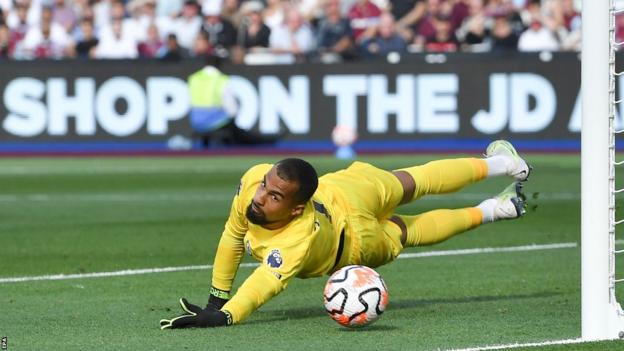Chelsea’s recent spending spree has featured high-priced superstar acquisitions, but their shrewdest move might be the £25 million signing of Robert Sanchez, a goalkeeper who was out of favor at his previous club, Brighton. When he arrived in August, questions arose about the rationale behind the transfer, as it was uncertain whether he’d secure significant playing time. Despite being a competent keeper, Sanchez’s performance statistics didn’t immediately indicate an upgrade over Kepa Arrizabalaga, making his selection as Chelsea’s number one goalkeeper in their bid to return to the Champions League places a surprising move given the significant financial investment.
Robert Sanchez’s remarkable impact on Chelsea: A game-changer in goal
Thus far, Sanchez has exceeded expectations by not only starting every game but also delivering outstanding performances. In the Premier League, only Tottenham’s Guglielmo Vicario (77.8%) and Liverpool’s Alisson (76.3%) boast higher save percentages than his impressive 75%. However, his impact extends beyond just making saves. He has notably influenced a team in the midst of a transition. Although we shouldn’t jump to conclusions as Mauricio Pochettino’s squad is still evolving, they initially grappled with goal-scoring and have yet to reach their full attacking potential. Nonetheless, there’s a noticeable improvement in their defensive solidity compared to last season.
Decoding Robert Sanchez’s unseen defensive mastery: Beyond the numbers
Sanchez’s unquestionable impact on elevating Chelsea’s defensive performance led me to develop a strong curiosity about the intricacies of this transformation. I intentionally moved away from my previous sole reliance on statistical analysis and delved into an extensive examination of the 25-year-old Spanish international’s on-field displays. What unfolded during this immersive process left me truly astonished, as the insights gleaned from closely observing him in action painted a narrative that diverged significantly from the straightforward numerical data, offering a deeper understanding of his influence on the team’s defensive solidity.
Robert Sanchez’s physical prowess: A goalkeeper of strength and grace
Unraveling the enigma behind Sanchez’s success, it’s crucial to start by examining his physical attributes. Standing at 6 feet 4.5 inches and weighing 90 kilograms, he exudes a commanding presence. While his height isn’t drastically different from Kepa (6 feet 2 inches) or former Chelsea goalkeeper Edouard Mendy (6 feet 3 inches), what truly sets Sanchez apart is the graceful way he utilizes his stature. Delving into footage from his matches this season, one striking feature emerges – his remarkable blend of size and extraordinary agility. This distinctive combination defines him as a goalkeeper who possesses both strength and lightning-quick reflexes.
Robert Sanchez’s tactical brilliance: Mastering goalkeeper positioning and awareness
Sanchez’s deliberate movement, as observed in a thorough analysis, reveals his exceptional efficiency in footwork and positioning. His standout trait is his innate spatial awareness, allowing him to maintain a keen sense of goal positioning, even during rapid transitions and opposition counter-attacks, minimizing unnecessary movements. He instinctively places himself in optimal positions to block shots or make interceptions. Additionally, Sanchez consistently displays astute angle selection and positioning, particularly when dealing with cut-backs and wide crosses. Whether in possession or not, he often holds a central stance, effectively covering a significant portion of the goal and enhancing his ability to defend with precision.
Robert Sanchez’s tactical mastery: The art of anticipating shooter intentions
Sanchez’s remarkable anticipation skills shine through as he combines patience with an acute ability to read the intentions of approaching shooters, as seen in games like those against Bournemouth and Brighton where he achieved clean sheets. He adeptly interprets these cues and preemptively leans in the right direction, enabling swift reactions to incoming shots. Notably, he strategically leverages his defenders to narrow the shooting angles for attackers, further enhancing his anticipation, although it involves a calculated risk. His choice of relying on defenders to protect either the near or far post hinges on the attacker’s approach to the ball, as exemplified in the Chelsea vs. Bournemouth match when he effectively utilized Axel Disasi to block the near post against Dominic Solanke.
